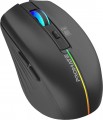Sensor resolution
Resolution of the sensor responsible for tracking mouse movements on the work surface. Specified in DPI — dots per inch.
The physical meaning of DPI as a whole is as follows. The sensor of a modern mouse works on the same principle as the camera matrix, and consists of pixels. And DPI is the number of pixels that fall on 1 inch of the underlying surface (length or width), "visible" by the sensor.
It is believed that more DPI means a more advanced sensor and mouse in general; nowadays, models for
3500 – 5000 DPI,
12000 DPI,
16000 DPI even
more are not uncommon. In a way, it is — high resolution contributes to accuracy. However, the only thing that is directly determined by this indicator is the speed at which the cursor moves across the screen: the higher the resolution of the sensor, the greater the number of pixels that the cursor will move when the mouse itself moves a certain distance. At the same time, it is worth recalling that too high a speed is even more undesirable than too low. So the real need for high DPI (
1000 and above) arises mainly when working on large screens (4K resolution and more); for more modest displays (HD and Full HD), smaller values are often enough.
quiet click
This feature means that the mouse keys, when pressed, sound much quieter than most "rodents". This is not necessarily completely silent operation — the sound may be present; but there are also absolutely silent models. Anyway,
"quiet click" can be a real lifesaver in situations where normal button clicks are undesirable — for example, if the mouse has to be used intensively at a late time, or if the user or others are very annoyed by clicks. However, note that the presence of a quiet click is indicated based on the manufacturer’s statements, and different brands may invest different meanings in the concept of “quiet”. So if the minimum noise level is critical for you, you should clarify the features of the selected model from additional sources, for example, video reviews or reviews.
Battery life
Battery life of the mouse (see “Power”) on a single charge.
The battery life in this case is rather approximate: it is given for an average usage scenario, and the actual autonomy may turn out to be less or more than stated, depending on the usage patterns. Nevertheless, it is a fairly reliable indicator, allowing different battery models to be evaluated and compared with each other: the difference in the stated battery life usually correlates well with the actual autonomy difference.
Weight
The total weight of the mouse. For models with a wired connection, usually, it is indicated without cable, and for devices with weight adjustment (see above) — without weights.
This parameter is important primarily for professional gaming applications, although it is often relevant for ordinary users. Theoretically, less weight promotes speed and reduces fatigue. At the same time, in fact, much depends on the personal habits and preferences of the user: a mouse that is too light may “not be felt in the hands” and not give familiar feedback. Therefore, although most mice have a lower weight limit of
60 – 80 g, however, even among professional gaming models there are much more massive devices —
120 – 140 g or
more. The lightest variety of "rodents" is laptop (see "In the direction"), among them devices come across and
less than 60 g.
Also note that the weight to some extent depends on the size and “tricked out” of the device, but there is no unambiguous dependence here: models similar in size and functionality can differ markedly in weight.

